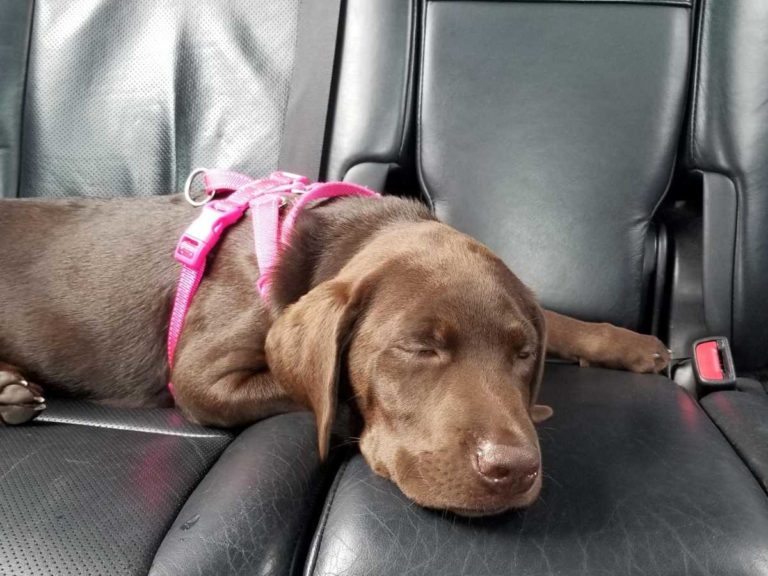If you are getting a new dog, especially a puppy, you might have heard about microchips for dogs. They are an option for pet owners developed as a way to help locate your pet if they are ever to go missing.
Microchipping your dog is a procedure in which a small microchip (about the size of a grain of rice) is implanted by your veterinarian.
How much does it cost to microchip your dog? And what are the benefits of getting your Lab microchipped?
We’re going to go over microchipping in more detail to help you understand more about its purpose, what it typically will cost to have it done, and what questions to ask your veterinarian about the procedure.
(This article may contain affiliate links. As an Amazon Associate I earn from qualifying purchases. Learn more)
Microchipping Your Dog: Costs & Benefits of Microchips For Labs
What Is Microchipping Your Dog?
Microchipping is a procedure in which a small microchip (about the size of a grain of rice) is implanted by your veterinarian under the skin of your pet, usually along their back. They are not just limited to dogs but are also available for cats and other pets.
This microchip is registered to a database with information about you, the dog’s owner, as well as other identifying information, such as your vet clinic’s name. You can also add additional contact information to your pet’s registry.
It basically works in conjunction with an online pet registry as a system to locate lost and found pets.
If your dog ever goes missing and is found by someone, such as animal control, a vet’s office, rescue, or shelter, the staff can use a handheld device to “scan” your dog to see if they have a microchip.
If the staff are able to detect a microchip, it will present them with a code number. By using this code, they can access the online database, and it will pull up any information in the registry associated with the code (such as your name, phone number, address, etc).
Most of the time, the microchip is inserted along your dog’s upper back, between their shoulders. When finding a lost dog, the shelter or vet staff will scan all around the dog’s back and shoulder area to try to detect the presence of a microchip.
Sometimes microchips can migrate from the area where they were originally implanted. Staff will usually do a thorough scan on a found animal to attempt to locate any possible chip, as they know that a dog with a microchip likely has a very worried owner who is motivated to get them back.
Microchipping is not a guarantee that you will get your dog back if they ever go missing, but it can dramatically increase the chances of getting them back!
And if you have an adventurous, impulsively curious Labrador like one of ours, who ran off one day and took himself to our local Buffalo Wild Wings restaurant, you’ll be happy to know when you’re chasing them down that the microchip adds an extra layer of protection in the event they are recovered!
You may also want to train them on a special command to help with impulse control in environments where they may be prone to bolting away from you, which you can read more about in The Critical Dog Training Command You Need to Teach Your Lab Today.
When Is Microchipping Usually Done?
Microchips are usually done in puppies, although if you adopt an older Labrador or rescue Lab, it’s definitely still possible to have it done. There isn’t an age limit to microchips that we’re aware of unless your vet feels it might pose a risk to your particular dog.
Sometimes Lab rescues will also microchip your dog as part of the adoption package.
If you’re planning to get a new puppy soon, be sure to read our guide on the 7 Things To Do Before You Bring Your New Puppy Home. We go into more details about the importance of setting up an initial puppy visit with your veterinarian, at which point you could also discuss microchipping with them.
Is Dog Microchipping Safe?
Microchipping is a relatively common and frequent procedure done in vet clinics, but as with any medical treatment, there could be risks. You should discuss those risks with your veterinarian before your dog undergoes microchipping.
We have not seen any negative effects from having any of our Labradors microchipped, but there could always be some chance of side effects from the injection site or risk of infection.
The procedure involves the use of a needle and one that may be on the larger side, which could cause your dog some discomfort if they are awake during the procedure.
To minimize the chance of pain for your Lab, ask your vet which way they recommend doing the microchipping procedure.

Cost of Microchipping Your Dog
The average cost of having your dog microchipped is about $40-$60, depending on location and cost of living in your area. It’s a procedure that only usually has to ever be done once in your dog’s life, so it shouldn’t be a recurring cost.
Microchipping is sometimes done at the same time as other treatments, such as spay/neuter surgery, or teeth cleaning procedures.
If your puppy or dog is already undergoing treatment, surgery, or procedure that requires the use of anesthesia, your vet might suggest microchipping at the same time (ours did).
If you are wanting to have your dog microchipped at a different time, such as when they aren’t under anesthesia, ask your vet if your pet would need anesthesia, or if it would cause them pain to have it done without.
We’ve been advised by several veterinarians that the microchip uses a larger needle size, so it might cause discomfort to your dog if done at a time when they aren’t anesthetized.
Of course, anesthesia itself carries its own risks, so you’ll want to weigh your options carefully and have a thorough discussion with your veterinarian about their recommendations.
We have always had our Labradors microchipped when they are under anesthesia for their spay/neuter surgery, but our veterinarian has also indicated that their office can do it as a separate appointment if you do not want to wait many months longer until the spay/neuter time.
If you are waiting longer to spay or neuter your dog, especially larger-breed dogs like Labradors, you should ask your veterinarian if they recommend waiting until then for the microchip, or if they suggest you do it earlier under a separate scheduled treatment.
In addition to the microchip fee, you will need to register your dog for the online registry, or else the microchip won’t provide any benefit if your dog goes missing.
There are several companies that provide an online registry, which we will go over a bit later on, but you should not be required to pay any fees to have your dog’s contact information in a registry. It should be free. Once you pay for the actual microchip implanted in your dog, the annual registry update should not cost you anything.
We’ve run into a few companies trying to appear as if you have to pay to have your microchip information in a registry, but what you’re really paying for are add-on services (which you may not want or need).
The registry portion should be free to provide your basic contact information to locate you in the event your dog goes missing.
Can I Microchip My Own Dog?
No, we don’t recommend you ever try to microchip your own dog!
Microchipping is a medical procedure performed by a veterinarian’s office, and not a procedure you should attempt to do on your own.
You could injure your pet, or yourself, attempting to do this procedure outside of a medical setting.
Also, since the goal of the microchip is to provide information in the event your pet is lost, the placement of the actual chip inside the dog’s body is critical to its success.
You will want someone placing the chip with expert precision to allow it to be more likely to be detected in the event that your dog is missing (and scanned for a possible chip).
For microchipping, you can have it done at your veterinarian’s office, and you may also be able to find microchipping services at other pet clinics.
You might also find microchipping available at animal shelters in your area, as well as at low-cost spay and neuter programs, which may offer this service in addition.
Will My Labrador Still Need a Collar and Tags?
Yes, we definitely still recommend that even if your dog is microchipped you still fit them with an appropriate collar, including tags for identification.
You will also want to make sure you have your dog’s rabies vaccine tag attached to their collar, as the microchip does not replace this information.
Depending on your location, you might also need to display your dog’s city or county dog license tag on their collar, if required.
The microchip is just one more level of protection for a lost pet to try to be reunited with their family in the event they go missing.
(Curious about whether it’s possible to use an Apple AirTag to track a missing pet? Check out Can an Apple AirTag Find Your Lost Dog?)
Where Can I Register My Dog’s Microchip Online?
There are several online services that provide a registry associated with your dog’s microchip code in the event your pet goes missing.
Some of the ones we’ve used before include HomeAgain.com and Michelson Found Animals at foundanimals.org.

Sometimes the brand of microchip that your veterinarian’s office selects will be linked to a specific registry. You will want to follow their exact instructions on registering your dog quickly and keeping the information updated.
Make sure if you move, change your phone number, or change your vet’s office that you update your information in the registry online. You should be able to do this free of charge.
This is an extremely important step because the microchip is only effective if it is linked to correct contact information.
Otherwise, if your pet is found, and the information is outdated or incorrect, there will be no way for you to be notified of their recovery and be contacted to get them.
We strongly encourage you to keep your microchip registry information updated!
Summary – Microchipping Your Labrador
Microchipping your dog is an optional procedure performed typically in a veterinarian’s office to help increase the chances of recovering your pet if they ever get lost or stolen.
It’s an additional level of protection to try to help reunite you with your pet, and for the cost of only $40-$60, will likely be worth it for the peace of mind it gives you.
Discuss the pros and cons of the procedure with your veterinarian, and please don’t try to do it yourself!
Register your dog’s microchip right away, and keep the information updated. We hope you never have a lost pet, but if you do, you might find that microchipping will help in bringing your dog home to you.







